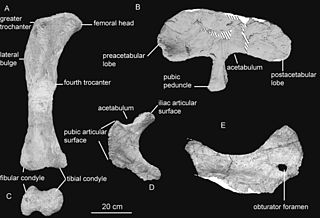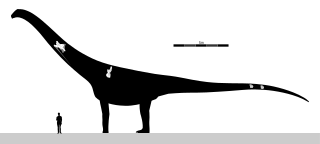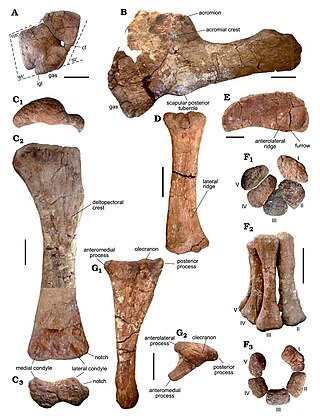
Argentinosaurus is a genus of giant sauropod dinosaur that lived during the Late Cretaceous period in what is now Argentina. Although it is only known from fragmentary remains, Argentinosaurus is one of the largest known land animals of all time, perhaps the largest, measuring 30–35 metres (98–115 ft) long and weighing 65–80 tonnes. It was a member of Titanosauria, the dominant group of sauropods during the Cretaceous. It is widely regarded by many paleontologists as the biggest dinosaur ever, and perhaps lengthwise the longest animal ever, though both claims have no concrete evidence yet.

Aeolosaurus is a genus of titanosaurian sauropod dinosaur from the Late Cretaceous Period of what is now South America. Like most sauropods, it would have been a quadrupedal herbivore with a long neck and tail. Aeolosaurus is well known for a titanosaur, as it is represented by the remains of several individuals belonging to at least two species. However, like most titanosaurs, no remains of the skull are known. The holotype of Aeolosaurus rionegrinus consists of a series of seven tail vertebrae, as well as parts of both forelimbs and the right hindlimb. It was discovered in the Angostura Colorada Formation in Argentina, which dates from the Campanian stage of the Late Cretaceous, about 83 to 74 million years ago. The species A. maximus was transferred over to the new genus Arrudatitan in 2021.

Bonitasaura is a titanosaurian dinosaur hailing from uppermost layers of the Late Cretaceous (Santonian) Bajo de la Carpa Formation, Neuquén Group of the eastern Neuquén Basin, located in Río Negro Province, Northwestern Patagonia, Argentina. The remains, consisting of a partial sub-adult skeleton jumbled in a small area of fluvial sandstone, including lower jaw with teeth, partial vertebrae series and limb bones, were described by Sebastian Apesteguía in 2004.

Limaysaurus is a genus represented by a single species of rebbachisaurid sauropod dinosaurs, which lived during the mid-Cretaceous period, about 99.6 to 97 million years ago, in the Cenomanian, in what is now South America.

Andesaurus is a genus of basal titanosaurian sauropod dinosaur which existed during the middle of the Cretaceous Period in South America. Like most sauropods, belonging to one of the largest animals ever to walk the Earth, it would have had a small head on the end of a long neck and an equally long tail.

Anabisetia is a genus of ornithopod dinosaur from the Late Cretaceous Period of Patagonia, South America. It was a small bipedal herbivore, around 2 metres long.

Neuquensaurus is a genus of saltasaurid sauropod dinosaur that lived in the Late Cretaceous, about 80 million years ago in Argentina in South America. Its fossils were recovered from outcrops of the Anacleto Formation around Cinco Saltos, near the Neuquén river from which its name is derived.

Rocasaurus is a genus of titanosaurian sauropod that lived in South America. Rocasaurus was discovered in Argentina in 2000, within the Allen Formation which is dated to be middle Campanian to early Maastrichtian in age. This genus grew up to 8 metres (26 ft) long, making it one of the smaller sauropods. It seems to be closely related to saltasaurid dinosaurs, like Saltasaurus and Neuquensaurus.
The Huincul Formation is a geologic formation of Late Cretaceous age of the Neuquén Basin that outcrops in the Mendoza, Río Negro and Neuquén Provinces of northern Patagonia, Argentina. It is the second formation in the Río Limay Subgroup, the oldest subgroup within the Neuquén Group. Formerly that subgroup was treated as a formation, and the Huincul Formation was known as the Huincul Member.

Pellegrinisaurus is a genus of titanosaurian sauropod dinosaur that lived in South America during the Late Cretaceous period. The holotype was found in the Allen Formation, Argentina.

Rinconsaurus is a genus of titanosaur sauropod dinosaur from the Late Cretaceous in what is now Argentina. The type species, Rinconsaurus caudamirus, was described by Calvo and Riga in 2003, and is based on three partial skeletons.

Puertasaurus is a genus of sauropod dinosaur that lived in South America during the Late Cretaceous Period. It is known from a single specimen recovered from sedimentary rocks of the Cerro Fortaleza Formation in southwestern Patagonia, Argentina, which probably is Campanian or Maastrichtian in age. The only species is Puertasaurus reuili. Described by the paleontologist Fernando Novas and colleagues in 2005, it was named in honor of Pablo Puerta and Santiago Reuil, who discovered and prepared the specimen. It consists of four well-preserved vertebrae, including one cervical, one dorsal, and two caudal vertebrae. Puertasaurus is a member of Titanosauria, the dominant group of sauropods during the Cretaceous.

Lognkosauria is a clade of giant long-necked sauropod dinosaurs within the clade Titanosauria. It includes some of the largest and heaviest dinosaurs known. They lived in South America and likely Asia during the Late Cretaceous period.
Traukutitan is a genus of titanosaur sauropod dinosaur which lived during the late Cretaceous.
Bonapartenykus is a monospecific genus of alvarezsauroid dinosaur from Argentina that lived during the Late Cretaceous (Campanian-Maastrichtian) in what is now the upper Allen Formation of the Río Negro Province. The type and only species, Bonapartenykus ultimus, is known from a nearly articulated but partial skeleton that was found in close association to two incomplete eggs and several clusters of eggshells belonging to the oogenus Arriagadoolithus. Bonapartenykus was named in 2012 by Federico L. Agnolin, Jaime E. Powell, Fernando E. Novas and Martin Kundrát. Bonapartenykus has an estimated length of 2.5 m (8.2 ft) and weight of 72 kg (159 lb), making it the largest member of the clade Alvarezsauroidea.

Katepensaurus is an extinct genus of rebbachisaurid sauropod dinosaur known from the Late Cretaceous of south-central Chubut Province of central Patagonia, Argentina. It contains a single species, Katepensaurus goicoecheai.

Notocolossus is a genus of titanosaurian sauropod dinosaur from late Cretaceous strata of Mendoza Province, Argentina.

The Ernesto Bachmann Paleontological Museum (MEB) in Villa El Chocón, Neuquén Province, Argentina, is a municipal museum dedicated to the paleontology, archaeology and history of Villa El Chocón and its surroundings.

Chucarosaurus is an extinct genus of titanosaurian dinosaur from the Late Cretaceous Huincul Formation of Argentina. The genus contains a single species, C. diripienda, known from various limb and pelvic bones.

Bustingorrytitan is a genus of lithostrotian titanosaur from the Late Cretaceous (Cenomanian) Huincul Formation of Argentina. The type species is Bustingorrytitan shiva.



























